
| FI:TCP/SYR/0103 (Mi) Field Document 5 June 1983 |
T E C H N I C A L C O O P E R A T I O N P R O G R A M M E

A report prepared for the
Improvement of Fisheries and
Aquaculture Production
Project
based on the work of
J. Garcia-Badell
(Consultant, General Engineering)
This informal report is one of a series of reports prepared during the course of the project identified on the title page. The conclusions and recommendations given in the report are those considered appropriate at the time of its preparation. They may be modified in the light of further knowledge gained at subsequent stages of the project.
The designations employed and the presentation of the material in this document do not imply the expression of any opinion whatsoever on the part of the United Nations or the Food and Agriculture Organization of the United Nations concerning the legal or constitutional status of any country, territory or sea area, or concerning the delimitation of frontiers.
FOOD AND AGRICULTURE ORGANIZATION OF THE UNITED NATIONS
Rome, 1983
Hyperlinks to non-FAO Internet sites do not imply any official endorsement of or responsibility for the opinions, ideas, data or products presented at these locations, or guarantee the validity of the information provided. The sole purpose of links to non-FAO sites is to indicate further information available on related topics.
This electronic document has been scanned using optical character recognition (OCR) software. FAO declines all responsibility for any discrepancies that may exist between the present document and its original printed version.
Appendix 1: ITINERARY FOLLOWED BY THE CONSULTANT
Appendix 2: LOCATION OF THE FISH-FARMS VISITED BY THE CONSULTANT
1. CALCULATION OF HEATING REQUIREMENTS OF A SMALL POND USING FLOATING PLASTIC DISCS
2. WATER TEMPERATURE VARIATION OF LAKE ASSAD DURING 1982
1a. Pond with a cover of floating plastic discs
4. New fish-farm (Homs Branch) Rableh
The Government of the Syrian Arab Republic, assisted by the Food and Agriculture Organization of the United Nations through the Technical Cooperation Programme, is engaged in a project whose main purpose is to improve the national fish production generally, and in particular to increase present aquaculture production and make recommendations on fisheries management.
As part of the project operation, FAO assigned Mr J. Garcia-Badell as consultant in aquaculture (general engineering) from 7 September to 1 October 1982 with the following terms of reference:
The aquaculture engineer will visit Government and private fish-farms. At each farm he will assess the major engineering problems which impair improved fish production such as water management (water supply and water use), farm design and construction.
On these bases, he will make specific recommendations for the improvement of the existing culture facilities in each of these farms.
Taking into account the nature of these recommendations, together with the potential for future development of inland fish culture at the national level, the consultant will assist in preparing a proposal for a UNDP/FAO technical assistance project in his field of specialization, but in close collaboration with the other members of the consulting team.
Appendix 1 gives the itinerary followed by the consultant and Appendix 2 is a map showing where the fish-farms are situated.
The General Establishment of Fisheries (GEF) owns at present 10 operating fish-farms, 7 of which produce carp and tilapia, 2 trout, and 1 carp and tilapia in floating cages. With a total water surface of 240 ha and an approximate flow of 2.5 m3/sec, a total of 97 t of trout, 700 t of carp and 220 t of tilapia are produced annually.
However, the GEF is planning the construction of 2 new fish-breeding establishments for trout, one in Rableh (Homs branch) with a flow of 4 m3/sec (almost double the present flow) and extension of the floating installations in Lake Assad in order to reach an additional production of:
| t/year | |
| Trout (Rableh fish farm) (new) | 320 |
| Trout (Floating cages) (new) | 1 260 |
| Total trout anticipated in the future | 1 580 |
| Total trout produced at present | 97 |
In order to achieve these results the construction of a new fish-breeding establishment in Rableh (Homs branch ) is necessary; this fish-farm, with a flow of 4 m3/sec, could supply fingerling to the entire country (20–60 g) to be reared in floating cages, as described hereunder.
The appropriate flow of water for trout is very limited throughout Syria (at present 2.5 m3/sec, with a possible 4 m3/sec). The water which supplies the Zabadani fish-farm is not of the quality required for a fingerling-producing centre which supplies the whole region. The same is true for Nib al Sin where the flow is limited and the water contains a high quantity of dissolved gas, having been pumped twice from Lake Sin.
The mere fact of converting all the existing fish-breeding establishments into producers of fingerlings (20–60 g) for fattening in floating cages would increase the national output tenfold, since a fingerling of 20–50 g needs ten times less water than a trout of 250 g intended for sale.
The suitable sites for installing floating cages are identified here, and others exist which are suitable for this type of culture.
There are no problems with regard to carp culture. The productivity of the ponds is excellent (4 m/ha) and Lake Assad could in the near future supply enough irrigation water for the creation, in earth ponds, of an aquatic ecosystem with a phytoplankton and zooplankton rich in protein, and which, with a suitable and cheap fertilizer, would enable yields of up to 2 m/ha to be obtained considerably decreasing the high costs involved in artificial feeding with granules.
The floating cages of Lake Assad are simple, economical, and easy to handle and keep in good working order. The production of carp in floating cages has great possibilities and its 105 t/year can be increased if the nets of the cages are modified to become more taut and deeper.
The number of floating cages can be doubled, since the bay where they are situated is large and deep enough to prevent a large fish population density causing eutrophication of the lake.
This area, situated 50 km to the south of Latakia, has 2 fish-breeding establishments. Nib al Sin where rainbow trout (Salmo gairdneri) is reared, and Masab al Sin which produces carp and tilapia. The water comes from a group of small lakes which converge into a large lake forming a river with a flow of 8–12 m3/sec.
The water of the Nib al Sin fish-farm is pumped from Lake Sin to a height of 8–9 m, while the water supply of Masab al Sin comes from a small river 4 km long.
2.1.1.1 Physical features
The Nib al Sin fish-farm which extends over 3 ha, consists of 111 rectangular concrete ponds, 36 × 4 × 1.30 m. It thus has a water capacity of 144 m3 per pond and a water surface of 15 984 m2.
The flow which supplies the fish-farm is pumped from Lake Sin; 1 000 1/sec is obtained. In view of the total capacity of the pond (144×111 = 15 984 m3) approximately 4 hours (too long) are necessary for the total renewal of the water, the flow of each pond being only 9 1/sec. The temperature of the water fluctuates between 15°C in January and 23.5°C in summer (August).
The oxygen dissolved in the water varies with the temperature, the average being 9 mg/1 at the inflow and 6 mg/1 at the outflow.
The pH of the water oscillates between 6.7 and 7.
This fish-farm is devoted to the fattening of fingerlings from a weight of 7, 15, 20 and 30 g to marketable size (200–250 g).
The fingerlings come from the Zabadani fish-farm, 400 km away, and are released into the ponds at a rate of 15 000 per pond, giving a density of 104 fingerlings/m3. When they weight 50 g (generally in August), they are selected and redistributed, so that they reach their marketable size (250 g) with a population density of 2 500–3 000 trout per pond (17–20 trout of 250 g/m3).
Annual production is therefore:
3 000 × 0.250 × 111 = 83 250 kg/year
with a density of:
83 250 kg/15 984 = 5.2 kg/m3
The feed, in the form of granules, is manufactured partly in Syria and partly imported from Italy, giving a conversion coefficient of 1.7:1 which it is hoped to reduce to 1.5:1.
2.1.2.2 Conclusions and recommendations
The flow of water of 1 000 1/sec is low if it is borne in mind that 4 hours are needed to renew the 15 984 m3 of water existing in the 111 ponds. (The normal renewal time would be one hour.)
The flow of each pond should be four times greater (4 × 9 1 = 36 1/sec). For this reason, a large quantity of solid matter, sediment and algae may be observed in the empty ponds which are difficult to clean and require costly manpower.
The structure of the fish-farm cannot be varied, since a considerable investment would be needed to modify all the sections of the piping. The pumping of the water from the lake is already very costly, but individual electric pumps could be used in each pond (these pumps have already been bought) to increase oxygenation and decrease the quantity of gases (N2 and CO2) in the water, in an attempt to combat the “gas bubble” disease from which the fish in this fish-farm suffer, and the symptoms of which are quite clear. These pumps could also be used to clean the bottom of the ponds, drawing off the debris and sediment deposited at the bottom.
The present production of 83 t/year could be increased to 130 t using individual electric pumps in each pond, but this solution is rather costly and it is more advisable, in view of the temperature which the water reaches in summer (23.5°C), to use the 300 1/sec which are available in the nearby station of Sourit and which are dispersed in the sea.
In order to decrease the high cost involved in obtaining water for the Nib al Sin fish-farm by pumping procedures with the consequent expenditure of electric energy, the following improvements are suggested:
to utilize the used water from this fish-farm to supply earth ponds which can be constructed on adjoining lands, where species such as common carp, Tilapia aurea and Mugil, could be reared, taking advantage of the 6 ha of existing land. The water coming from the concrete ponds could easily reach the temperature of 28°C, appropriate for the culture of species well suited for development purposes;
to take advantage of the flow of 300 1/sec available in Sourit for the production of 20–25 t of rainbow trout. This new fish-farm would consist of 8 ponds of 40 × 4 × 1.3 m, each supplied with 37.5 1/sec and would be entirely devoted to the fattening of fingerlings from Zabadani.
However, it would be advisable before starting the work to carry out a more thorough survey of the quality and temperature of the water throughout the year, since the data obtained at present are incomplete.
2.1.2.1 Physical features
This fish-farm, situated 50 km to the south of Latakia and with a total area of 80 ha, 60 ha of which are water, and a flow of 250 1/sec, rears 200 t of common carp (Cyprinus carpio) and 65 t of tilapia (Tilapia aurea and T. galileus).
The water comes from the River Sin which in turn flows from Lake Sin. Of the 60 ha of water, 50 ha correspond to 13 rectangular ponds of approximately 3.8 ha each, i.e.,
13 small ponds (nursing ponds) of 0.5 ha
3 ponds of 0.5 ha for carp brood stock
3 ponds of 0.5 ha for tilapia brood stock
The pH of the water is 7 and the temperatures vary from a minimum of -3°C in January to a maximum of 41°C in August; the months of December, January and February are the most critical for tilapia culture, as the water temperature falls below 10°C.
Among the tilapias, T. aurea is the species most resistant to cold, but in winter it has to be moved to more protected ponds, which involves substantial manpower costs; and in spite of this there is a high mortality rate.
It is possible to raise the water temperature in the ponds to more than 10°C by procedures which are technically simple but expensive to implement, as for instance winter storage devices which cover part or the whole pond. In some countries these devices are essential if it is desired to cultivate species which are very susceptible to the cold.
A more economical solution, which may be successful in countries with less rigorous climates, consists in covering part of the surface of the ponds with floating plastic discs. Water loses most of its calories through its surface, while the bottom of the pond is an accumulator of recuperable energy.
An original method could be to cover the surface of a small pond partly or totally with floating plastic discs (see Figure 1), which absorb solar radiation during the day and conserve it during the night, thus avoiding heat losses due to evaporation and wind. The disc, which is easy to construct, is inflatable and is made of transparent plastic on its upper surface and black plastic at the bottom of the float which absorbs the solar radiation and transmits it to the water surface.
According to the data obtained, in the locality of Masab al Sin, the pond water in January reaches a maximum temperature of 20°C during the day, falling to as low as -4°C during the night.
The cover of inflatable plastic discs would enable this maximum temperature to be increased and maintained above 11°C during the night. This solution would solve the problem of mortality of tilapia in the period December-February and, if necessary, make it possible to increase the temperature of the water during the rest of the year in order to obtain an optimum development of the fish.
The construction of the floating discs is simple and their duration long if plastic materials of the Tedlar-40 type are used. The solar radiation penetrates the upper transparent film and 70 percent is absorbed by the black bottom of the float. In order to avoid the pressure and force of the wind on the disc it is advisable to fill part of its air chamber with water.
On the basis of the solar radiation received in a latitude of approximately 35° (Latakia) and knowing the percentage of losses, the efficiency of the collector disc, the losses of heat through radiation, evaporation and convection, and the square metres needed to collect solar energy in order to maintain the maximum temperature of 24°C in January have been calculated (Table 1).
It can be deduced from these calculations that it would be feasible to cover half the surface of a small pond with floating discs to prevent the water temperature falling below the danger point (+ 10°C), and in addition to provide further solar energy to increase the temperature during the rest of the year which would have a positive influence on fish development.
2.1.2.2 Reproduction and development of common carp
Reproduction of common carp (Cyprinus carpio) is carried out naturally, using for this purpose the “hapa” situated in the nursing ponds. Reproduction starts in March/April, 200 000 fingerlings (1–2 g) per hectare being placed in the nursing ponds.
By September/October, that is in 7 months, they reach 30–50 g and then the entire second year is devoted to fattening the fish to the size of 1 kg.
Common carp and tilapia polyculture is carried out in the following proportions:
SPRING
7 000 tilapia of 50 g/ha
5 000 carp of 25 g/ha
In autumn the tilapia easily reach 350 g while the carp exceed 800 g. This implies a total yield of up to 6 t/ha.
FERTILIZATION OF THE PONDS
Fertilization of the different ponds is carried out as follows:
NURSING POND
Lime: 400–600 kg/ha
Chicken manure: 3 t/ha
Cow manure: 6 t/ha
Ammonium nitrate (26% N): 50 kg/ha
FATTENING PONDS
Cow manure: 6 t/ha/year
Ammonium nitrate (26%): 50 kg/ha × 2
Triple superphosphate (46% P2O5) 60 kg/ha × 1
Urea (46% N): 30 kg/ha
Cow manure: 4 t/ha every 3 months
2.1.2.3 Production
Masab al Sin is one of the most productive fish-farms of the region since, according to the data obtained, it produces in a stretch of 60 ha of ponds 200 t of common carp and 60 t of tilapia, i.e., an average yield of 4 t/ha.
The conversion factor or feed/gain-in-weight ratio is 3:1.
Artificial feeding is carried out with granules manufactured in the country.
2.1.2.4 Recommendations and Considerations
The yields obtained in common carp and tilapia polyculture in Masab al Sin are excellent; however, they could be improved - in line with experiments carried out in many countries - if new species are introduced:
(a) Mugil cephalus and Mugil capito
All the organic and chemical fertilizers introduced into the ponds cause a super-production of phytoplankton which is utilized only by phytoplanktophagous fish as in the case of Mugil. These green and blue algae die en masse causing a lack of oxygen in the water during their period of decomposition.
In the case of common carp, Tilapia aurea and Mugil polyculture, advantage should thus be taken of the phytoplankton, and total yields increased by 30 percent.
Association of these species in polyculture can be in the following proportions:
Common carp: 84%
Tilapia aurea: 10%
Mugil cephalus: 6%
It is advisable to add grass carp (Ctenopharyngodon idella) to this three-species polyculture in a proportion of 250/ha to control the excess growth of macrophytes in the ponds.
The high price which Mugil fetches on the world market should also be remembered; in fact, this fish fetches more than double the price of common carp.
However, the factor which limits the culture of this species is the difficulty which generally exists in obtaining the necessary supply of fingerlings.
(b) Silver carp
In order to improve the polyculture and make it less expensive, it is necessary to increase the quantity of fertilizers in the ponds, adding chemical and organic fertilizers and decreasing artificial feeding; however, the addition of all these materials causes a more abundant growth of phytoplankton, composed generally of blue and green algae (see above).
To re-establish the biological equilibrium of the pond, it is necessary to introduce another phytoplanktonophagous fish species which consumes this surplus phytoplankton; this is the case of Hypophthalmichthys molitrix, a distant relative of the carps, but which in spite of this is known as “Chinese silver carp”.
In this common carp and silver carp polyculture an increase of 38 percent in the weight reached by the common carp has been noted.
The greatest benefit obtained by the mixed rearing of silver carp and European carp has been the great saving of artificial feed. With feed derived only from organic and chemical fertilization very satisfactory results have been obtained.
Neither should the possibilities which the utilization of agricultural and industrial effluents has from an economic point of view be overlooked. Moreoever, waste used as nutrients can be very varied (silk industry, vegetable waste, fermented rice and wheat products, etc.).
At present a huge concrete dam 4 500 m wide, 512 m thick at the base and 60 m high contains the waters of Lake Assad, 80 km long and with more than 12 million m3 impounded, which in the very near future will be able to irrigate all the 640 000 ha of agricultural land foreseen in the plan.
2.2.1.1 Floating cages
The floating cages are situated in a bay well protected from the wind and near to the town of Ath Thawra (see plan).
The project was drawn up in the Federal Republic of Germany in 1970 and was constructed almost entirely with Syrian materials.
It consists of a total of 100 cages, each with 35 m3 capacity, where the common carp is reared during a fattening period from April or May until November.
The procedure to be followed is described below: in May 1 500 carp of 30 g are released into each 35 m3 cage; in July/August these carp have attained a weight of 70–100 g and in November they reach marketable size (700 g).
The yield per cage is 1 050 kg and the general total in 7 months is 105 t, which makes an average of 30 kg/m3/7 months - a very acceptable quantity considering that the recommendable maximum should not exceed 40 kg/m3.
The temperature of the water varies throughout the year (Table 2). In May it already reaches 22°C and in August 26.6°C.
The solubility of the oxygen in the water varies with the temperature and reaches figures near to saturation:
8.0 mg/l at 24°C
9.4 mg/l at 18°C
which indicates that there is sufficient wind and swell in the lake to beat and oxygenate the water.
The pH is rather high.
2.2.1.2 Components of floating cages
The floating cages installed in Ath Thawra consist of the following elements:
sustaining structure
floating structure
cages
anchorage system
The sustaining structure is formed by steel bars soldered together in the form of a parallelepiped and inside which are placed the drums which act as floats.
These drums of galvanized steelplate fit into the cavity formed by the anglebars. The whole structure is double in form (I). On its upper part a pinewood floorboarding serves as a gangway around which the cages are placed.
Cages: Their framework of galvanized steel tubes (4.5 × 3 m) is kept afloat by a simple anchorage device and an intermediate float or drum. Each model consists therefore of four cages 4.5 × 3 m and 3 m in depth.
The anchorage system is formed by steel cables attached to the shore by large concrete blocks and lateral anchorages to prevent them from turning.
This set of floating cages is simple, manageable and easily manoeuvrable; the average cost is US$ 600 per cage of 35 m3, and they can be built easily. The joints are simple and the structure does not deteriorate as it is well protected from strong winds and swells.
The Grice hanging automatic feeders are perfectly functional and some have already been manufactured in Syria.
2.2.1.3 Conclusions and recommendations
(a) Knotless nylon nets should be used to prevent damage to the fish. Various commercial makes exist: Nylon, Perlon, Dederon, Ulstron, Courlene. The colour should be dark in order to avoid fouling by the algae. The use is recommended of as large as possible a mesh which will at the same time prevent the fish from escaping, and allow maximum oxygenation and minimum fouling. Generally, it is most suitable to use a mesh length equal to the tenth part of the length of the fish. It should be borne in mind that a faulty renewal of the water has a great influence on the yields obtained.
(b) In order to prevent fouling of the nets the following procedures are suggested:
Chemical Method
a special anti-algae paint (Lagotex).
Biological Method
A biological method of algae control consists in introducing 30 Mugil cephalus of 20 g for each m3 of enclosures, that is, a total of 1 050 Mugil fingerlings of 20 g for each cage of 35 m3, making a total of 22 kg for each net.
Tilapia nilotica also eat the colonies of algae adhering to the nets, and its culture together with common carp and rainbow trout is very useful. It should also be noted that silver carp is capable of filtering large quantities of algae for its food.
(c) Twice the yield of carp can be obtained if the net enclosure is lowered to a depth of 6 m, thus obtaining a total capacity of 4.1 × 2.8 × 6 m = 70 m3 (present depth 3 m).
The tautening of the bottom of the nets should be carried out by a rectangle formed by galvanized 1-inch tubes filled with sand, in this way the parallelepiped will be perfect and the net will not rise to the surface. The fouling with algae will be less since it has been proved that these only grow at 1.5 m from the surface. The carp will be more protected from solar radiation and will only come up to eat.
In each 6 m deep floating cage (70 m3 of real capacity) 70 × 40 kg/m3 = 2 800 kg of the following species could be cultivated:
0.71% × 2 800 = 2 000 kg Cyprinus carpio
0.145% × 2 800 = 400 kg Mugil cephalus
0.145% × 2 800 = 400 kg Tilapia nilotica
(d) Trout (Salmo gairdneri) culture in floating cages: The temperature of the water in Lake Assad during the months of July-August to mid-September is very high although the oxygenation coefficient which is close to saturation point remains at 8 mg/1.
During the winter, trout (Salmo gairdneri) culture was attempted and most encouraging results were obtained, the fingerlings of 40 g introduced into the cages reaching 300 g of weight in 5 months. In some cases the population density of the trout should not exceed 20 kg/m3, and an effort should be made to ensure that the rearing site is sufficiently far away from the carp to avoid possible contagious diseases.
Suitable sites for trout culture in floating cages are very frequent all along the coast of Lake Assad but those near to the town of Ath Thawra and therefore to the already existing fish-farm, and which are both protected from the wind and the strong current and swells, are less abundant. The two zones marked in Fig. 3 have the stipulated conditions. In the extensive area which they cover more than 600 floating cages could be installed, and given that the unit capacity (for 6 m deep nets) is 70 m3, the admissible total is 42 000 m3, which, considering an average population density of 30 kg/m3/ year, could yield the considerable quantity of 1 260 t/year.
The fish-farms at present existing in Syria are limited in number and possibilities, e.g., Nib al Sin whose flow is at the most 1 000 1/sec and whose production is 80 t.
However, a fish-farm devoted solely to the production of fingerlings of 60 g (September) would have a capacity ten times greater, since it is well known that fingerlings of 60 g need ten times less oxygen than trout of 250 g intended for sale. Therefore, using floating cages, the country's trout production could be increased tenfold and it should not be forgotten that suitable springs and rivers for salmonids are not very abundant in Syria. Moreover, floating installations cost much less (US$ 17/m3 floating structure; US$ 80/m3 traditional concrete structure).
Observing the temperature of the water of Lake Assad, there exists a suitable period for salmonids starting mid-September and lasting until the beginning of July.
It is recommended to carry out an economic survey of the estimated cost during 3 months (July-September) of pumping the cold water from a depth of 30 m, since the temperature of the lake at this height above sea level only reaches 16°C in summer, and although the water lacks the necessary oxygen, its recuperation on the surface seems technically and economically feasible.
It is also noted that the much lower cost of the floating installations would allow for additional moderate expenditure.
Although the trout market is not sufficiently widespread in Syria at the moment, it would develop rapidly if salmonids were obtained at low cost.
Attention should also be drawn to the importance and the saving of foreign exchange which the export of “smoked” trout would entail; the technique of preserving this fish is simple and the demand for it is considered to be very high in western countries.
(e) Other species which might be reared in the waters of Lake Assad: Among the new fish culture techniques the wide interest which the utilization of its 12 million impounded cubic metres might entail for this country should not be forgotten. Multiple utilization of the water would be feasible. First, it would be used to create an abundance of fish in the dam itself, either in its deep waters or at the surface by means of floating cages. Later, the water would be used to produce electric energy for urban consumption, and before using it for farm irrigation it would again be used for the construction of ponds built on poor agricultural lands which could have a controlled water supply.
Some omnivorous or detrivorous phytophagous and zooplanktonophagous species could be most useful if abundant irrigation water and suitable impermeable lands were available where ponds could be constructed and the emptying and filling of these controlled, creating an aquatic ecosystem where the minerals are stored together with the gurry in the sediments, where the fertilizers which in general are expensive can be substituted by organic supplies in plant form, where waste may come from agricultural industries, fermented products of rice, silk and wheat, without forgetting the recycling of the residual water with which, thanks to the food which they have in suspension, it will be possible to obtain a yield of fish of up to 4 t/ha without the need for costly artificial feed.
A new aquaculture or fish-rearing system associated with agriculture should be projected such that the benefits will be reciprocal; and where both water and land are exploited coherently, extracting from the agro-system, the maximum possible energy without exhausting or impairing it.
Among the species most suited for the culture, particular attention is drawn to the following types of polyculture:
| Common carp (Cyprinus carpio) | earth ponds (polyculture) and floating cages (monoculture) |
| Tilapia aurea | |
| Mugil | |
| The so-called Chinese carps | |
| Ctenopharyngodon idella(grass carp) | earth ponds (polyculture) floating cages floating cages, earth ponds |
| Hypophthalmichthys molitrix (silver carp) | |
| Aristichthys nobilis | |
| Cirrhina molitorella | |
| Silurus glanis (catfish) | |
Silurus glanis is present in the waters of Lake Assad. It is a fish which easily adapts to intensive culture in floating cages and earth ponds and readily accepts artificial feeding. Catfish is the fish most cultivated in North America and is esteemed above all for the quality of its flesh which remains perfectly good when frozen. In some experiments, the cultivation in rotation of rice or cotton and catfish considerably decreased the low productivity of the agricultural lands, supplying them with, among other things, a large additional quantity of nitrogen which is very important for this type of cultivation.
2.2.1.4 Feeding
Most of the fish feed in the form of granules is imported from Italy, and another very large part is manufactured in Syria. Based on the cost of the products employed and their composition: proteins, fats, cellulose, glucides and minerals, the following formula has been composed:
| Fresh ground fish | 6% |
| Fish flour (herring) | 4% |
| Blood and remains of animals | 14% |
| Silk industry residues | 17% |
| Cottonseeds | 10% |
| Wheat | 18% |
| Bran | 7% |
| Ground white maize | 13% |
| Cellulose waste | 5% |
| Groundnut cake | 6% |
| Vitamins | 3 kg/t |
| Minerals | 2.5 t |
Hypersaturation of gases is frequent in flowing water or in water from springs that surge from the ground under pressure, in those which flow through excessively calcareous lands and in those conducted forcibly under pressure by pumping. This seems to be the case in the Zabadani fish-farm with transport of the water under excessive pressure, variations of the oxygen content of the ponds, high temperature and excessive exposure to solar light. Changes of the ponds with ostensible differences in aeration are one of the factors which have a definite influence on the occurrence of bubble disease, also called gas disease or gas embolism.
The symptoms of this disease take two forms:
Exophthalmos and subcutaneous exanthema due to the excess of nitrogen or gas embolism through excess of nitrogen and symptoms of intoxication by carbon dioxide.
The symptomatology consists in the formation and appearance of gas bubbles in different regions of the body and lower jaw, and with an edematous reddish colouration of the gills, which makes the fish swim at the surface on their side or more frequently with their belly upwards.
In the fingerlings the gas bubbles extend along the caudal fin, first with unilateral prominence and then with bilateral prominence of the eyes which ultimately come out of their sockets causing mortal haemorrhage. In adult trout the symptoms are simple or double exophthalmos and a black colouration of the external surface which results fatally in ocular enucleation and haemorrhage and a high mortality rate, especially in ponds situated at the water inlet.
Attention should also be drawn to the importance which the utilization of water containing an excess of dissolved gases might have for the incubation of eggs, since the bubbles may adhere to their cover and impede the regular process. Fish suffer from this disease both in the fish-farm of Zabadani and at Nib al Sin. In both farms a number of bubbles may be observed which emerge from the water, particularly at Nib al Sin farm, after it has been pumped from Lake Sin.
The solution to this problem is simple but at the same time costly: the water should be aerated to liberate the excess gases. This is achieved by intercalating waterfalls or electric aerators, or by means of a degasifying tank which frees the CO2 and N2, and increments the oxygen.
During the visit to Lake Homs the feasibility of installing floating cages in this lake was analysed.
The characteristics of these waters are such that this plan was discarded since the drawbacks were much greater than the advantages and could have a considerable influence on the cost of the installation.
Only the upper half of Lake Homs, where the waters are not yet contaminated by urban and agricultural effluents, could be utilized. Generally, the water is not deep enough for the installation of this type of exploitation (minimum 8 m) and where it is deep enough it is too far from the shore.
The west winds are almost continuous and quite intense, which would affect the resistance of the floating structures and consequently the cost.
There are very few zones within the lake which are protected from the strong swell.
The communication routes are few and costly to construct.
In Homs branch there is a very suitable area for the installation of a new fish-farm with a capacity for producing the necessary fingerlings for fattening in floating cages and trout of 250 g destined for sale.
The river coming from the mountains on the frontier with the Lebanon has a flow in the summer which might well reach 6 m3/sec. The water is of good quality, well oxygenated (9.5 mg/1), and the temperature is very suitable for trout culture (17.5°C in September). The pH 8 is also acceptable.
The water intake from the river could easily be effected at a narrowing of the water-course where a dam must once have existed to conduct the water through an underground piping system to a mill at present out-of-use.
A canal will have to be constructed with a capacity for 4.5 m3/sec which follows the same course as that already existing and which will make it possible to supply the ponds intended for fingerlings and trout fattening (Fig. 4). The ponds could be arranged on the existing 3 ha of land once it has all been levelled. A hundred ponds of 50 × 4 × 1.3 m with a unit flow of 40 1/sec could be devoted to the production of 320 t of trout (Salmo gairdneri) leaving the remaining 500 1/sec for the production of fingerlings in circular ponds.
This fish-farm could absorb a quantity of fingerlings at present produced at the fish-farm of Zabadani and has an enviable situation, not only because of its excellent characteristics for producing quality fish, but also its proximity to Lebanon - a potential market.
Table 1
CALCULATION OF HEATING REQUIREMENTS
OF A SMALL POND USING FLOATING
PLASTIC DISCS
| Latitude (Baniyas) | 35° | |
(Latakia) | ||
| Winter average energy income | 1.28 × 104 | kJ/m2/day |
| Percentage possible sunshine | 70% | |
| Disc collector efficiency | 80% | |
| Daily collector yield = 1.28 × 104 × 0.7 × 0.8 | 7.2 × 103 | kJ/m2/day |
| Pond surface water | 400 | m2 |
| Pond surface covered with collector | 250 | m2 |
| Evaporation energy loss | -1.1 × 106 | kJ/day |
| Radiation imbalance loss | -0.9 × 106 | kJ/day |
| Convection and wind loss | -0.01 × 106 | kJ/day |
| Solar input to pond through gaps | 0.4 × 106 | kJ/day |
| Net daily energy loss | -1.6 × 106 | kJ/day |
| Area of collector required | 220 | m2 |
Table 2
WATER TEMPERATURE VARIATION OF LAKE ASSAD DURING 1982
| Surface | Jan. | Feb. | Mar. | Apr. | May | June | July | Aug. | Sep. | Oct. | Nov. | Dec. | |
| Temperature °C | Minimum | 9 | 9 | 9.6 | 10.8 | 16 | 22 | 23.4 | 26 | 24.6 | 19 | 15.6 | 11.8 |
| Maximum | 13 | 9.8 | 10.8 | 15 | 22 | 23.6 | 25.4 | 26.6 | 26.6 | 24.6 | 18.8 | ||
| pH | 9.3 | 8.8 | 8.6 | 8.2 | 8.2 | 8.2 | 8.2 | 8.2 | |||||
| 5 m depth Temperature | Minimum | 9.6 | 8.0 | 10.5 | 17.3 | 23.8 | 25.6 | 25.8 | |||||
| Maximum | |||||||||||||
| pH | 9.1 | 8.7 | 8.6 | 8.2 | 8.2 | 8.2 | 8.2 | 8.2 | |||||
| Arrival | Departure | |
| Madrid | 7.9.1982 | |
| Rome | 7.9.1982 | 10.9.1982 |
| Damascus | 10.9.1982 | 13.9.1982 |
| Homs | 13.9.1982 | 13.9.1982 |
| Latakia | 14.9.1982 | 19.9.1982 |
| Ath Thawra | 19.9.1982 | 21.9.1982 |
| Damascus | 21.9.1982 | 25.9.1982 |
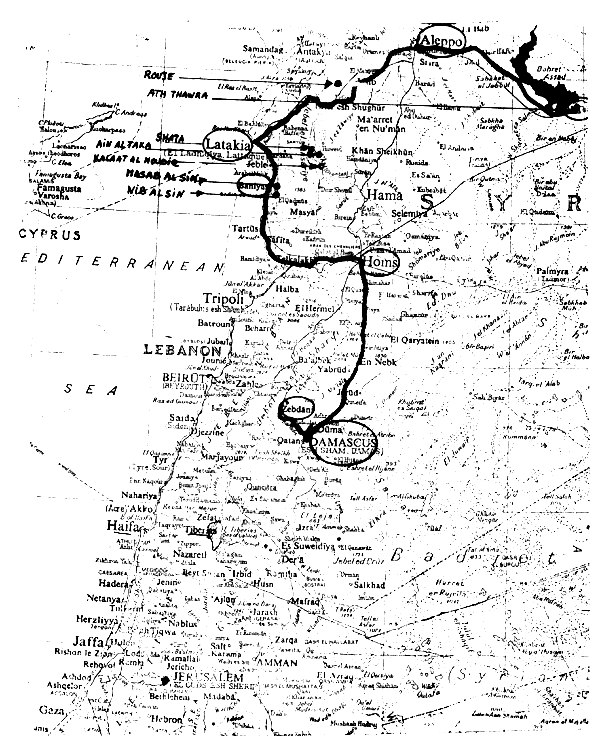
Location of the fish-farms visited by the consultant
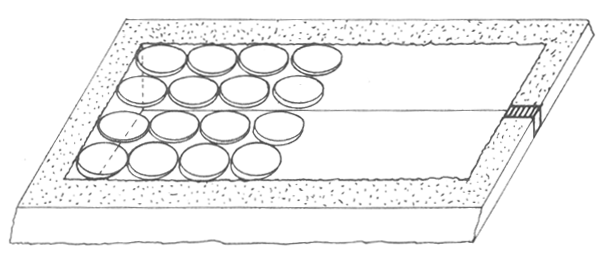
Fig. 1a Pond with a cover of floating plastic discs
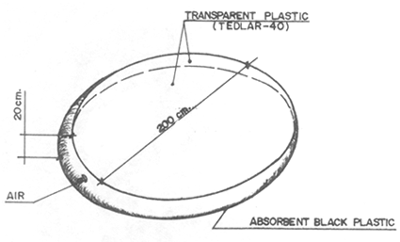
Fig. 1b Floating plastic disc
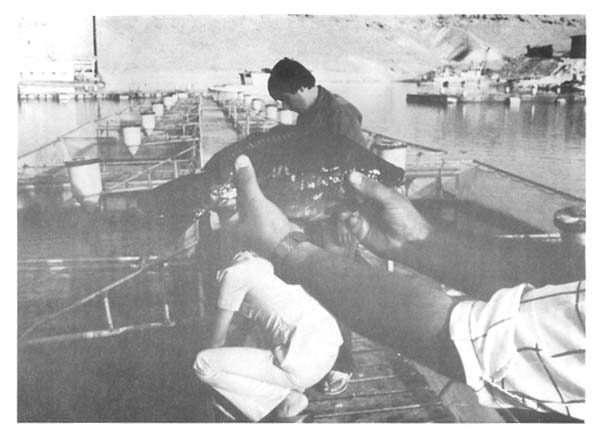
Fig. 2a Floating cage Lake Assad

Fig. 2b Cyprinus carpio (700 g)
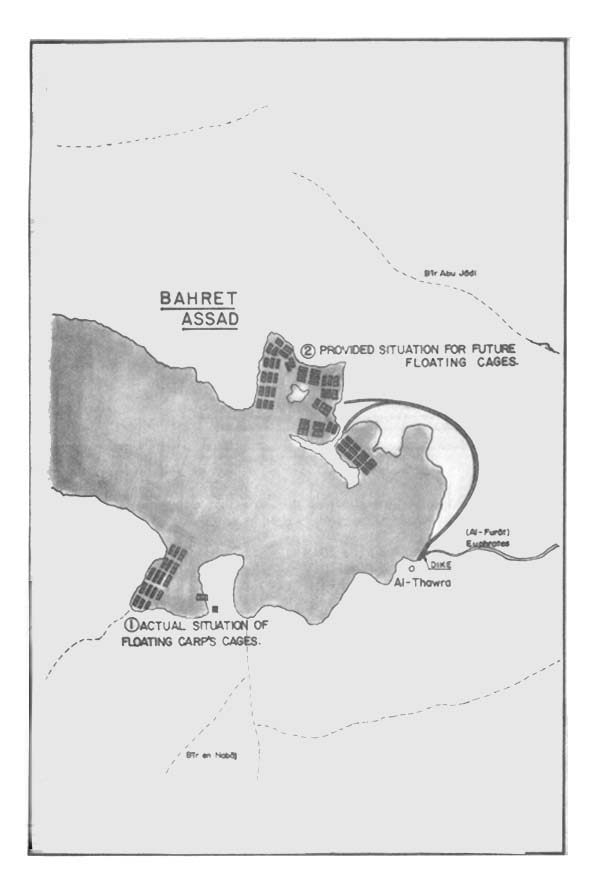
Fig. 3 Location of floating cages
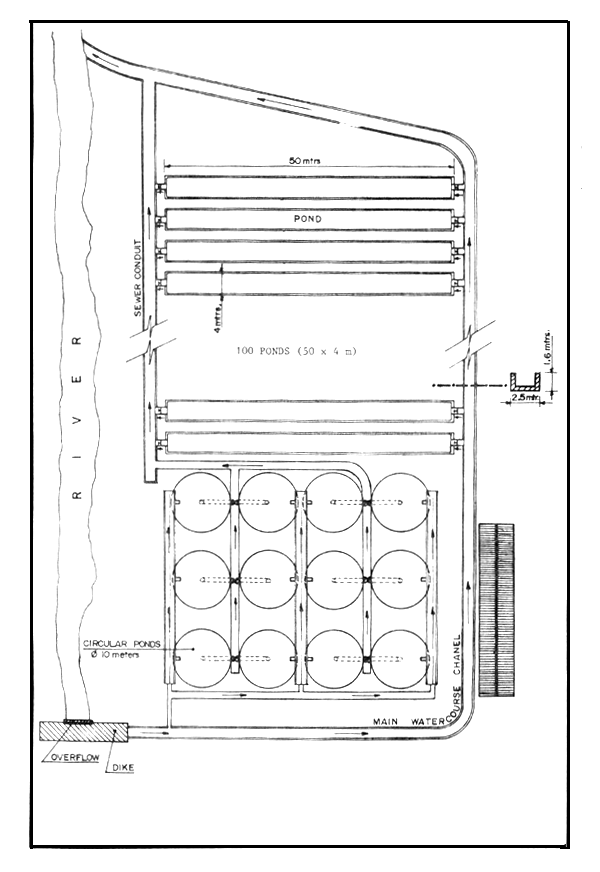
Fig. 4 New fish-farm (Homs Branch) Rableh
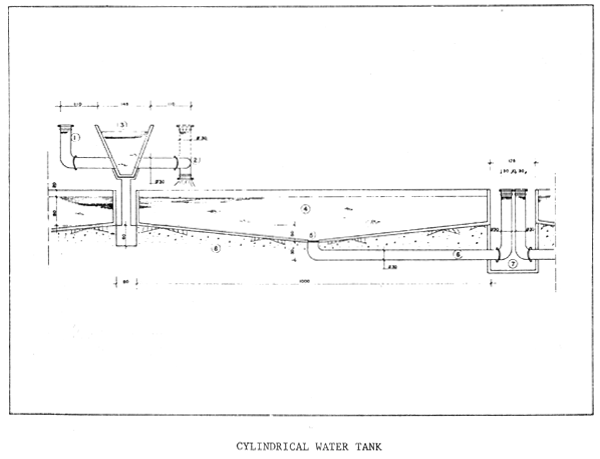
CYLINDRICAL WATER TANK
Fig. 5 (1) (2) and (6) revolving “ARTOMA” pipe which regulates the
inflow and outflow of the water according to its position
(3) prefabricated irrigation canal
(4) prefabricated cylindrical water tank
(5) grating
(7) irrigation canal for drainage
(8) compressed earth
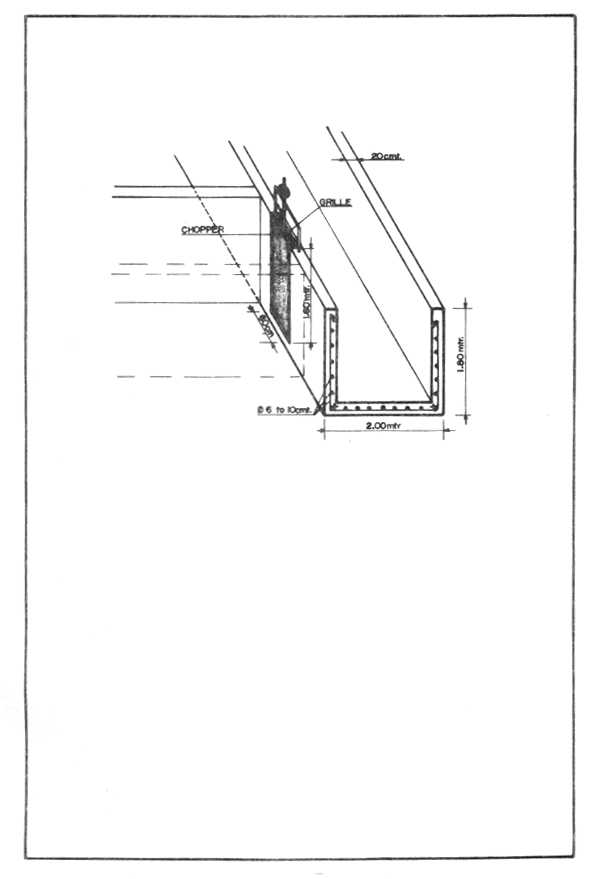
Fig. 6 Chopper's pond